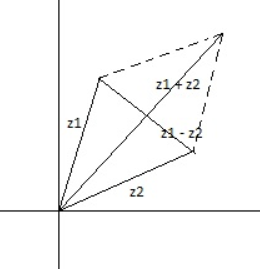Question
Question: Let z1 and z2 be two complex numbers such that z1 \(\ne \) z2 and |z1| = |z2|. If z1 has positive r...
Let z1 and z2 be two complex numbers such that z1 = z2 and |z1| = |z2|. If z1 has positive real part and z2 has negative imaginary part, then z1−z2z1+z2 may be which of the following:
(a) Purely imaginary
(b) Real and positive
(c) Real and negative
(d) None of these
Solution
Hint: Consider vectors along the position vector of z1 and z2 in the Argand Plane and with magnitude equal to |z1| and |z2|. A rhombus will be formed as shown in the figure with z1 + z2 and z1 - z2 in the directions of the diagonals. Use the fact that the diagonals of a rhombus are perpendicular to each other to get z1 + z2 and z1 - z2 will be perpendicular to each other. This means that z1−z2z1+z2 will have an argument of ±2π which gives us the final answer.
Complete step by step answer:
In this question, we are given that z1 and z2 are two complex numbers such that z1 = z2 and |z1| = |z2|. Also, z1 has a positive real part and z2 has a negative imaginary part.
Using this information, we need to find the nature of z1−z2z1+z2.
We are given that |z1| = |z2|.
Consider vectors along the position vector of z1 and z2 in the Argand Plane and with magnitude equal to |z1| and |z2|.
A rhombus will be formed. Consider the rhombus formed as shown in the figure below:

The vector along z1 + z2 will be in the direction of one of the diagonals, while the vector along z1 - z2 will be along the direction of the other diagonal.
We know that the diagonals of a rhombus are perpendicular to each other.
Hence, z1 + z2 and z1 - z2 will be perpendicular to each other
So, z1−z2z1+z2 will have an argument of ±2π.
Hence, z1−z2z1+z2 will be purely imaginary.
So, option (a) is correct.
Note: We can solve this question by another lengthy method also. Let z1 = a + bi and z2 = c + di. Now, find z1−z2z1+z2by substituting these. Simplify this and then use the fact that |z1| = |z2| to get a2+b2=c2+d2. Substitute this in the previous expression to get the answer.Students should remember if z1 + z2 and z1 - z2 are perpendicular to each then z1−z2z1+z2 will have an argument ±2π.
which says the real part is 0 i.e It is purely imaginary.
